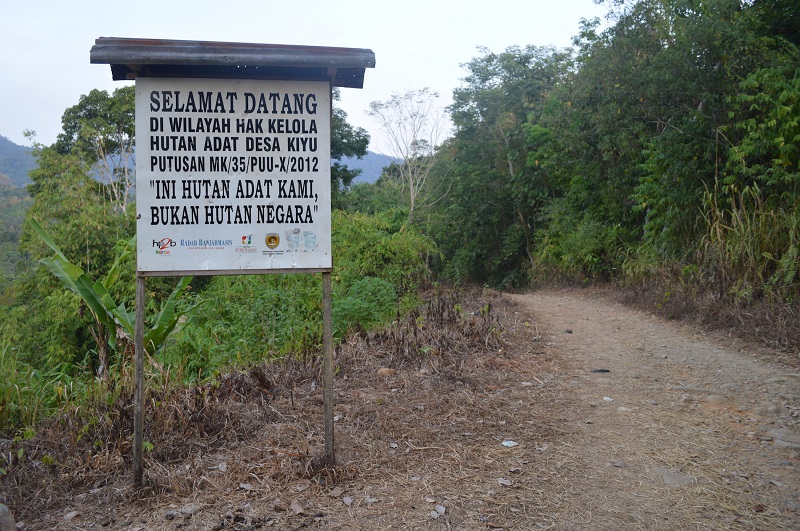Compromises must be made in the quest for indigeneity among the Dayak Meratus
Compromises must be made in the quest for indigeneity among the Dayak Meratus
Setting foot in the Kiyu forest in South Kalimantan, visitors are greeted by a sign at the entrance: ‘Welcome to the territory of the Kiyu customary forest under Constitutional Court Decree No. 35/PUU-X/2012’. The sign also declares, ‘THIS IS OUR CUSTOMARY FOREST, NOT STATE FOREST.’
Located deep in the Meratus Mountains, the Balai Kiyu is an example of a traditional community successfully engaged in activism – with help from the nation-wide indigenous movement led by AMAN (Indigenous Peoples’ Alliance of the Archipelago). The sign mentioning the decree is a powerful symbol of their involvement in the modern legal discourse of indigeneity.
A closer look at the dynamics of activism, however, shows that the relationship has been give-and-take. The struggle for rights has led the Balai Kiyu, one of many Balai communities in the area, to adjust some of their own concepts – such as that of customary territory – to better fit with the dominant legal discourse, in the hope of acknowledgement. Though the struggle for indigenous autonomy provides many benefits, it risks submerging traditional identity in national and global discourses of indigeneity.
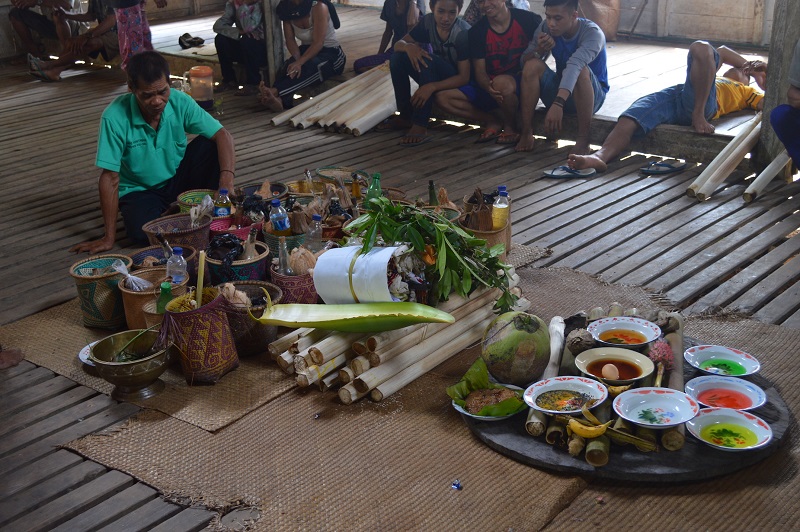 |
|
Members of the Balai Kiyu community during Aruh Pisit, a ritual for storing harvested grain. The articulation of an indigenous identity proved instrumental in gaining an effective political voice. (Jazak Akbar Hidayat) |
The origins of activism
Activism among the Balai communities has its roots in the efforts of the Aliansi Meratus (Meratus Alliance) in 1999, when they opposed the provincial government’s plan to grant a concession to a Korean timber company. This concession would have forced indigenous villages to engage in a land swap. An area of 46,270 hectares of protected forest in the district of Hulu Sungai Tengah (HST) was to become a limited production forest under PT. Kodeco Timber, according to a decree by the Minister of Forestry.
The Balai communities engaged in a series of protests. To support the struggle, several local NGOs and university Nature Clubs invited their broader networks of NGOs to form an alliance. A meeting of more than 30 NGOs, as well as the Balai communities, was held in November 1999 to formulate strategies.
The series of actions taken by the alliance from 1999 to 2001 resulted in the HST government preserving the existing district spatial plan. The proposed concession area remained protected forest, where any industrial activity is prohibited. The company was forced to halt its development plans, due to the conflict of policies between district and national levels.
Succeeding in preventing the concession, the alliance had accomplished its goal. Though the alliance was subsequently disbanded, the case had taught both NGO activists and the Balai communities about the importance of having a recognised, and respected, identity.
Articulating new identity
In 2003, supported by AMAN and local NGOs, the Balai communities held a congress in Banjarmasin. They established their own organisation, PERMADA (the Customary Communities Union). The move also affirmed a new identity of the Balai communities as ‘Dayak Meratus’ (the ‘Meratus Dayak’ people), replacing the derogatory label ‘orang bukit’ (hill people) – which was widely used by the dominant Banjarese ethnic group. This new identity, and their organisation’s affiliation with AMAN, placed these communities within the burgeoning indigenous movement.
In 2007, AMAN changed its membership structure from NGOs and individuals to individual communities. The involvement of the Balai communities in the movement became more intensive. In 2010, AMAN formally established a regional chapter in South Kalimantan – where the Balai communities serve on the board – to manage local issues and integrate them into broader advocacy campaigns. This provincial level chapter oversees local chapters based in seven districts, and claims to have 171 Balai communities as members.
Both PERMADA and AMAN were giving the Balai communities an experience of indigeneity as a socio-political contestation. The Balai communities now had space to show their identity and boundaries to external stakeholders, such as the government and companies.
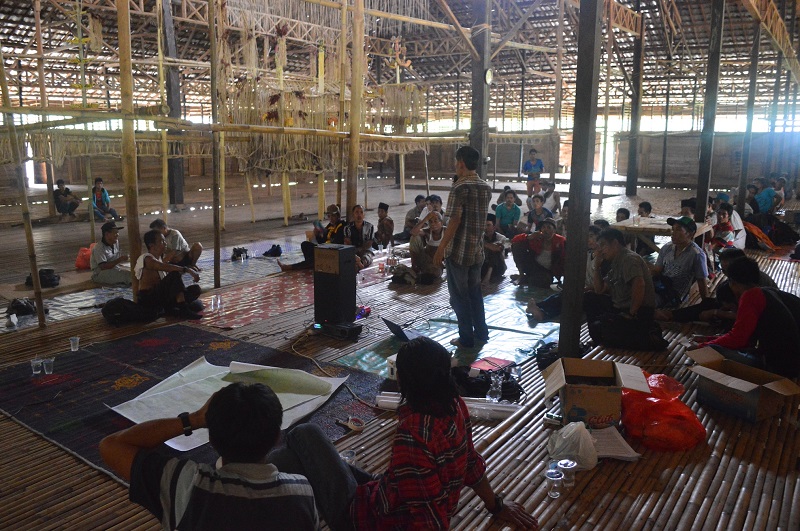 |
|
Members of the Balai communities of Loksado, Meratus Mountains, attending a meeting in their Balai Adat (house of worship), held by local and national NGOs. (Jazak Akbar Hidayat) |
Redefining Balai territory
The notion of boundaries, however, affected relations among the Balai communities. As the indigenous movement sought for legal recognition of customary territory, the definition of Balai customary territories was altered to fit in with legal requirements. Participatory mapping using modern techniques and tools was introduced, and through this process, the Balai communities’ traditional territorial system – based on natural landmarks such as rivers, hills or trees – was replaced with units such as metres and hectares.
While some Balai communities supported the mapping process, others were suspicious of or against the mapping. They feared that the data would be sold to companies, or argued that the definitive borders might create conflicts among Balai communities and their members.
Once the territories were mapped, there was a long process before applying to the regional parliament. The application was for a regulation to legally establishing the Balai communities’ tenure – this route was considered better than applying for a District Head’s Decree, which is susceptible to change with political succession. In 2015, the Balai communities of Loksado in the district of Hulu Sungai Selatan (HSS) – the neighbouring district to HST – were the first Balai communities to start this process.
The Balai communities had difficulty navigating these procedures. At the time of application, some of them were still questioning the implications of being legally recognised. However, the process remains on track and has received indications of support from the HSS council.
In the name of indigeneity
As this process demonstrates, maintaining an indigenous identity is not straightforward. Though the process seeks for the perpetuation of hereditary traditions, it requires adoption of aspects of the dominant modern political and legal system. Constructing indigeneity is less about returning to an authentic pre-colonial tradition, than it is about negotiating a new articulation of that traditional identity.
In their struggle for recognition of land rights, the Balai communities had to join the global indigenous movement introduced by NGOs to affirm their indigeneity. The Balai communities also had to makes compromises in order for territories for which their customary claims were initially denied to be accepted by, and represented to, the hegemonic social, political and legal discourse of the state.
For better or worse, indigeneity has likely become the Balai communities’ new articulation of their identity, through which they obtain space to speak and to be heard.
Jazak Akbar Hidayat (jazakbar@yahoo.com) is a PhD candidate in the Social Work and Policy Studies program at the University of Sydney.
Related articles from the archive
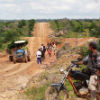 |
Dec 09, 2014 |
 |
Jun 24, 2013 |
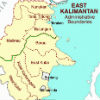 |
Oct 18, 2009 |

